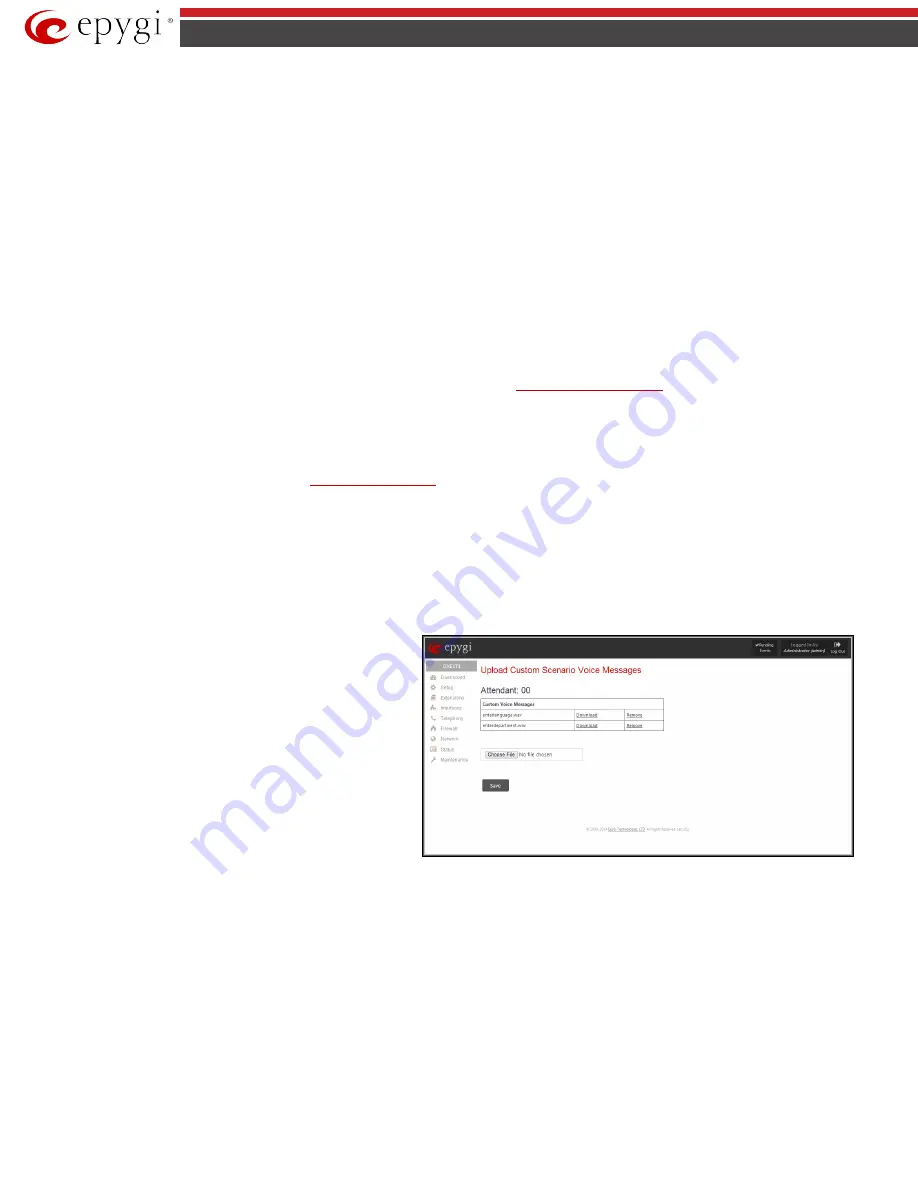
QX5
QXFXO4/QXISDN4/QXE1T1/QXFXS24; (SW Version 6.0.x)
26
QXFXO4/QXISDN4/QXE1T1/QXFXS24 Manual II: Administrator’s Guide
Choose File
opens the file chooser window to browse for a new welcome message file.
The
Download Welcome Message
and
Remove Welcome Message
links appear only if a file has been uploaded previously. The
Download
Welcome Message
link is used to download the message file to the PC and opens the file-chooser window where the saving location may be
specified. The
Remove Welcome Message
link is used to restore the default welcome message.
•
Recurring Attendant Prompt
-
this group allows updating the active recurring Auto Attendant message (played after the Attendant Welcome
Message and then periodically repeated while being in the Auto Attendant), downloading it to the PC, or restoring the default one. The group
offers the following components:
Upload new Recurring Attendant Prompt
indicates the file name used to upload a new recurring auto attendant prompt. The uploaded file
needs to be in PCMU (CCITT u-law, 8 kHz, 8 bit Mono) wave format, otherwise the system will prevent uploading and the “Invalid audio file, or
format is not supported” warning message will appear. The system also prevents uploading if there is not enough memory available for the
corresponding extension. This will cause the “You do not have enough space” warning message to appear.
Choose File
opens the file chooser window to browse for a new Recurring Attendant Prompt file.
The
Download Recurring Attendant Prompt
and
Remove Recurring Attendant Prompt
links appear only if a file has been uploaded
previously. The
Download Recurring Attendant Prompt
link is used to download the Recurring Attendant Prompt file to the PC and opens the
file-chooser window where the saving location may be specified. The
Remove Recurring Attendant Prompt
link is used to restore the default
Recurring Attendant Prompt.
•
Friendly Phones
-
the
Edit Authorized Phones Database
link refers to the
page where a list of trusted external
phones can be created. If external SIP or PSTN users are added to the QX Authorized Phones database, they are free to access the Auto Attendant
Services without passing the authentication or to use the Call Back services.
The
VXML Scenario
manipulation radio button selection allows you to upload Attendant’s custom scenario file and voice messages. The selections are:
•
The
Upload VXML Scenario File
indicates the file name used to upload a new scenario file. The uploaded file needs to be in EpygiXML format
(the coding standard can be found aChoose File
opens the file chooser window
to browse for a custom scenario file.
Please Note:
You may upload an attendant scenario file along with the voice prompt recordings as a single file. To do this, create an archive file
of the “tar.gz” type containing all the necessary files and upload it from the
Upload VXML Scenario Voice Messages
page.
•
The
View/Download VXML Scenario
link appears only when a custom scenario file has been previously uploaded and is used to view or
download the scenario file. The
Remove Scenario
link is used to remove a custom scenario file and return to the default Auto Attendant
scenario.
•
The
Upload VXML Scenario Voice Messages
link refers to the page where voice messages used in the uploaded custom scenario should be
managed.
This page provides the possibility of uploading voice messages to
be played in the custom Auto Attendant scenario. It also removes
and downloads the uploaded files to a PC.
The
Upload Custom Scenario Voice Messages
page contains a
table where uploaded custom voice messages are listed. Use the
Download
functional button to download and use
Remove
to
delete the corresponding custom voice message.
Choose File
opens a file chooser window to browse for a custom
voice message for an archive file with the “tar.gz” extension
containing the custom attendant scenario and the voice prompt
recordings.
Fig.II- 27: Upload Custom Voice Messages page
The
Attendant Ringing Announcement
group allows uploading an optional voice message that is played to callers instead of ring-back tones when
making calls through an auto attendant. The
Ringing Announcement
can be enabled for both custom and default attendants.
Please Note:
The
Attendant Ringing Announcement
is played to SIP-to-extension and PSTN-to-extension calls only. The announcement can also be
played to SIP-attendant-SIP and PSTN-attendant-SIP calls if they are made by a call routing rule for which the RTP proxy is enabled.
The group offers the following components:
The
Enable Ringing Announcement
checkbox enables/disables the Auto Attendant optional announcement message. When this checkbox is selected but
no custom announcement message is uploaded, the default message will be played to callers.
•
File
selection is used to upload the ringing announcement file. The following option is available under this selection:
Upload new ringing announcement
indicates the file name used to upload an announcement. The uploaded file needs to be in PCMU (CCITT
u-law, 8 kHz, 8 bit Mono) wave format, otherwise the system will prevent uploading and the “Invalid audio file, or format is not supported”






























